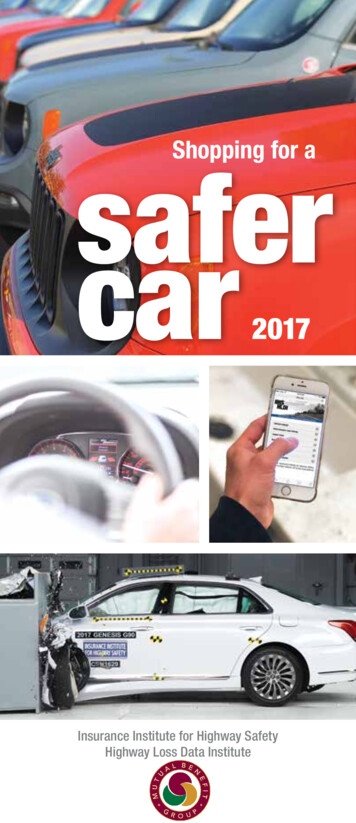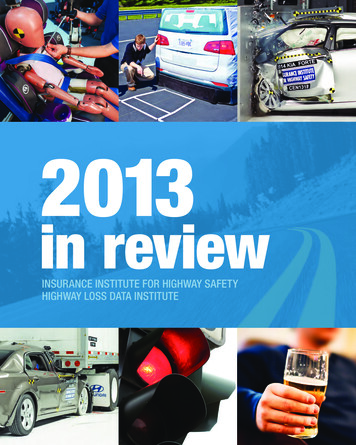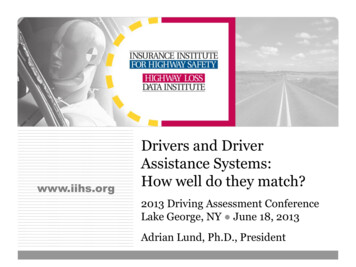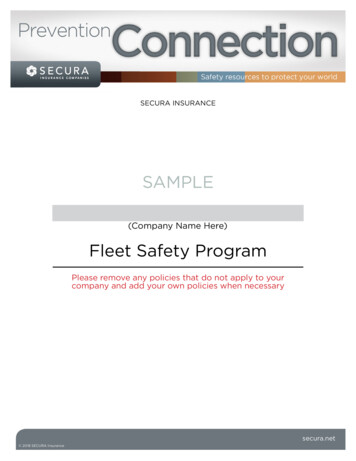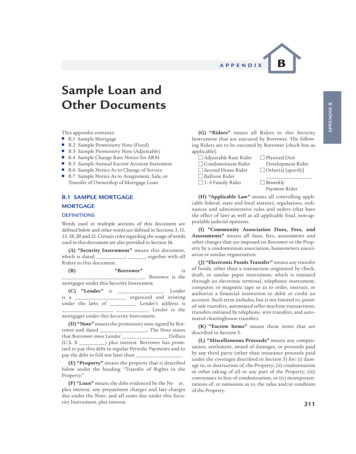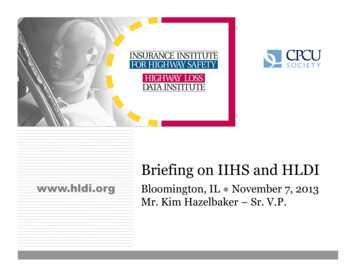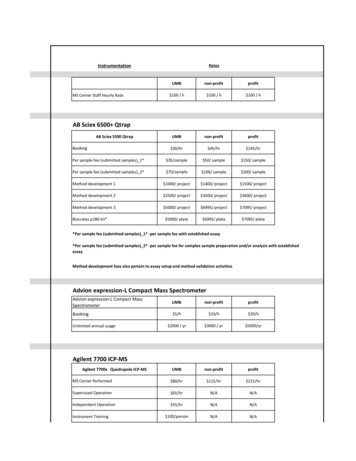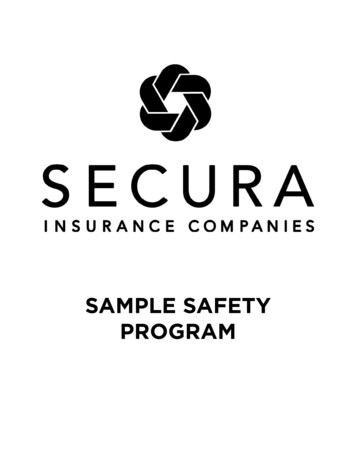
Transcription
SAMPLE SAFETYPROGRAM
IntroductionSECURA Insurance is providing this free sample safety program as a service and value added benefit to ourpolicyholders. It is in both of our interests to encourage implementation of this cost saving program. A formal safetyprogram can positively impact the bottom line profitability of your business. We feel that this is one way to controlyour overhead costs and increase the profits to your company.Feel free to use this as a model and refine any part of the program you deem necessary to fit your operations.To be effective your safety program should become a day to day part of your business. Even if talked aboutinformally, safe behavior can become part of your business culture.
Table of ContentsPART 1 - RATIONALEI.PurposeII.Property DamageIII.Production InterferenceIV.Employee MoraleV.Public RelationsPART 2 - RISK MANAGEMENT PROGRAMI.Loss Prevention PolicyII.Pre-Employment SurveyIII.New Employee OrientationIV.Specialized Loss Prevention TrainingV.Loss Prevention EngineeringVI.Personal Protective EquipmentVII.Loss Prevention / Safety RulesVIII.Hazard Communication ProgramIX.InvestigationX.Inspection ScheduleXI.Safety CommitteeXII.SupervisorsXIII.Hearing ConservationXIV.XIV First-Aid TrainingPART 3 - EXPENSE CONTROLI.Designated Medical ProvidersII.Employer ResponseIII.Immediate InvestigationIV.Return-to-Work Policy (Light Duty)PART 4 – ATTACHMENTSAttachment 1: Guidelines for Safety Training Meetings.Attachment 2: General Safety RulesAttachment 3: Material Safety Data Sheet ExplanationAttachment 4: Safety Check ListsAttachment 5: Transitional Duty Program ImplementationAttachment 6: Injured Employee Contact PlanAttachment 7: Transitional Duty Procedures for EmployeesAttachment 8: Sample Letter to Doctor for Transitional DutyAttachment 9: Transitional Duty Agreement FormAttachment 10: Transitional Duty Procedures for Employee
PART 1 RATIONALELoss Prevention & Loss Control IntroductionThese procedures are presented with the overall goal of helping to prevent accidents and increasing safetyawareness. Loss prevention must be an integral part of a company’s operations and must be built into every processand procedure. This document is only a guideline and is not intended to address every safety area.I.PURPOSEEmployers should use every safeguard and precaution available to protect employees from on-the-job injuries.Significant economic gains may result from an organized accident prevention program.An accident is any unplanned or unforeseen event that interrupts the work schedule and may include propertydamage or injury.Risk management must become part of every operation to maximize production efficiency and eliminate injuries.Consider the following COSTS:Direct: Cost of medical and indemnity payments for the injured worker (workers’ compensation). Cost of property damage Increased insurance costs in the future.Indirect: Cost of business interruption Public and employee relations Lost or damaged equipment. Lost time from employees discussing accident.The costs associated with workers’ compensation impact the employer in two ways:1.Rate Classification: Rates are usually calculated on the loss experience (costs) associated with a specificclass of employment. There are approximately 600 different classifications of employment in the ratemaking system. The Commissioner of Insurance determines rates based on recommendations from theNational Council on Compensation Insurance (NCCI).The Commissioner of Insurance determines rates with respect to adequate funding to pay claims andadministrative expenses and to ensure economic survival of the insurer.According to a sample state NCCI rate schedule, rates for each 100 of a payroll ranged from .26 fortraveling auditors to 58.78 for steel erectors. This is based on the past and expected future costs incurredwithin these classifications.2. Experience Modification: Each individual employer’s historical, actual incurred losses are compared withNCCI expected losses for the employer’s given classifications and payroll. A factor of a decimal (creditmodification), unity, or a whole number plus a decimal (debit modification) is derived and applied(multiplied) to the basic premium. For example:a. Basic premium 8,000 Modifier (debit) x 1.15 Cost of coverage 9,200b. Basic premium 8,000 Modifier x1.0 Cost of Coverage 8,000c. Basic premium 8,000 Modifier (credit) x .90 Cost of coverage 7,200The above data shows that the employer in example “c”, operating a successful loss prevention/control program,pays 2,000 less than the employer in example “a” for the same coverage.
II. PROPERTY DAMAGEThe costs associated with property damage are usually obvious and determined quickly. These losses may bereadily insurable but frequently require a significant co- payment.III. PRODUCTION INTERFERENCEIn the area of business interruption, the costs are difficult to measure and are usually overlooked. In an industrialaccident, indirect costs may be many times the direct costs. The following indirect cost items are found inevery accident: Production loss due to shutdown of machinery or processes under the control of an injured employee. Time lost by fellow employees assisting the injured employee, discussing the accident and returning tonormal production schedules. Loss of future business or goodwill for failure to meet production schedules. Time spent by the supervisor to prepare the accident report, investigate the accident, assist the injuredemployee and train a replacement. Possible decreased efficiency of the injured employee for the period immediately following a return to work. Decreased efficiency of the replacement. Wages paid to the employee for the time lost on the date of the accident.IV. EMPLOYEE MORALEA low accident rate can be an important factor in establishing a reputation as a good employer. Employees mayview an effective accident prevention program with a low injury rate as management’s interest in employee welfare.V. PUBLIC RELATIONSPoor safety records have an unfavorable effect on public opinion and may result in decreased consumeracceptance of products. This is particularly true when catastrophes such as explosions and major fires receivewide publicity. An outstanding safety record can be used to improve public relations. A poor safety recordmay give the employer a bad reputation. This makes it difficult to maintain good community relations and mayhinder recruitment of a satisfactory labor force during periods of low unemployment.PART 2 - RISK MANAGEMENT PROGRAMI.Risk Management Policy StatementThe Safety Program should begin with a declaration of a Prevention and Loss Control Policy from top management.A good policy makes it easier to enforce safe practices and conditions, to implement company goals, to followsafety rules and to maintain equipment.Basic to a policy declaration are these statements: Safety and health of employees, the public and company is the highest priority. Prevention of accidents is more important than short cuts or haste. Every attempt will be made to reduce the possibility of accident occurrence.The National Safety Council offers the following examples of policy statements: When workers enter the employ of this company, they have a right to expect a proper place to work andproper machines and tools to do their jobs. They can devote their energies to their work without fear ofpossible harm to their life and health. Only under such circumstances can the relationship between employer and employee be mutuallyprofitable and harmonious. It is our desire (a) to provide a safe workplace, safe equipment, propermaterials and (b) to establish and insist upon safe methods and practices at all times.
It is a basic responsibility of all executives to make the safety of human beings a part of their daily, hourlyconcern. This responsibility must be accepted by all who have a part in the affairs of the corporation, nomatter in what capacity they may function. Management considers no phase of operation or administration more important than accident prevention.It is the policy of the company to provide and maintain safe and healthful working conditions and tofollow operating practices that will safeguard all employees and result in safe working conditions andefficient operation. We believe in the dignity and importance of the individual employees and in their rights to derive personalsatisfaction from their employment. In this creed is our belief that the safety of employees continues to bethe first consideration in the operation of the business. Safety is our responsibility in management. Without question it is our number one responsibility, takingprecedence over everything else. Accident prevention and efficient production go hand-in-hand. All levels of management have a primaryresponsibility for the safety and well-being of all employees. This responsibility is met only by workingcontinuously to promote safe work practices among all employees and to maintain property andequipment in safe operating conditions. The supervisor is the key in the safety program because he or she is in constant contact with employees.No supervisor or operating head may ever be relieved of any part of the responsibility for safety. Safety isan operating function and cannot be transferred to a staff organization.Safe practices by employees must be part of all operations. No job shall be considered efficiently completedunless workers have followed every precaution and safety rule to protect themselves and their fellow workers.The ideals of production and safety are inseparable.“Total safety” extends into three important areas: company personnel, products and customers, and the public.This policy is implemented in the following ways:a. Development and application of safety standards both for production facilities (equipment, tools, workmethods and safeguarding) and for products, based on applicable legal and voluntary codes, rules andstandards as a minimum.b. Safety inspection to identify potential hazards, both in production and in products. Packaging, labelingand instruction sheets are designed to minimize hazards or alert users to hazards inherent in the product.c. Accident investigation to determine cause of accidents and prevent recurrence.d. Accident records and accident-cause analysis to determine accident trends and provide targets forcorrective action.e. Education and training in general safety principles and techniques. Include on- the-job safety instructionby the supervisor and periodic supervisory contacts for new instructions, follow up and generalsafety motivation.f. Protective equipment to provide personal protection in hazardous areas.g. Industrial hygiene studies to identify potential health hazards and develop necessary protective measures.h. Safety publicity and promotion to set up program interest and participation.i. Off-the-job accident prevention in cooperation with public and private agencies to promote theapplication of accident prevention principles to non-work activities.II. PRE-EMPLOYMENT SURVEY (QUESTIONNAIRE)The pre-employment survey should not discriminate against workers who sustained past injuries and aresufficiently recovered to return to work. It should ensure the safety and well-being of all workers by notrequiring them to work at tasks exceeding their physical limitations. A physical examination could be doneto ensure that the job assignment is not a hazard to an individual or co-workers. Remember: all efforts mustconform to the standards of the Americans with Disabilities Act (ADA).
III. NEW EMPLOYEE ORIENTATIONNew workers are most vulnerable to accidents. Studies show that 85-90% of all accidents involve unsafepractices by new employees in the overall workforce. For example, workers who have been on the job a monthor less account for 25% of all accidents.At a minimum, orientation should include the following elements: Company /plant/job site general safety rules Emergency response and evacuation procedures Fire prevention and reporting procedures Hazard identification and reporting Personal protective equipment pertaining to requirements of specific job responsibilities Electrical safety Housekeeping Hazard communication program Workers’ Compensation Rights and Responsibilities: Reporting requirements Reporting of all unsafe conditions Reporting of all injuries or “near misses”New employee orientation should be documented. This may be a checklist with the signatures of the trainer andthe employee. That new employee document should become part of the employee’s permanent personnel file.New employee orientation is only the first step in the overall training, continuing with constant reinforcement.IV. SPECIALIZED RISK MANAGEMENT TRAININGMake all employees aware of the hazards inherent in their specific duties and all measures to do jobs safely.The first-line supervisor must thoroughly train workers performing an unfamiliar task in: Methods Procedures Personal protective equipment Precautionary or safety practices to be followed Prevailing safety rules associated with specific tasksThe first-line supervisor and employee should sign off with the date of completion of each training exercise.See Attachment 1, Guidelines for Loss Prevention Training Meetings.V. LOSS CONTROL ENGINEERINGThe objective in this phase is to design equipment and processes and to plan job procedures so that exposureto injury is eliminated or controlled.Considerations:Is there a danger of striking against, being struck by, or otherwise being injured by an object? Can employees be caught in, on, or between objects? Can they slip or trip? Can they fall on the same level or to another? Can they strain themselves by pushing, pulling, or lifting? Is the environment hazardous? (toxic gas, vapor, mist, fume, dust, heat, or radiation)Principal Solutions: Find a new way to do the job. Change the physical conditions that create the hazards. Eliminate hazards still present by changing thejob procedure.
Try to reduce the necessity of doing a job or the frequency that it must be performed. This is particularlyhelpful in maintenance.The possible applications for these principles are innumerable and sometimes very complex. Often, such asin case of ventilation, this requires experts with highly specialized knowledge of these specific concerns andremedies. Your insurance carrier can assist in developing this program.VI. PERSONAL PROTECTIVE EQUIPMENTPersonal protective equipment (PPE) becomes necessary when a hazardous exposure is impractical or impossibleto eliminate by engineering revision, safeguarding, or limiting exposure time. When it is determined that PPE isnecessary, there are two important considerations:1.The proper equipment is selected. For example, a mask designed to protect against particulates is worthlessagainst vapor, gases or fumes. If there is doubt, contact the supplier to assure that the application conformsto standards as set forth by: American National Standards Institute American Society for Testing and Materials The National Institute for Occupational Safety and Health Mining Safety and Health Administration2. The supervisor needs to make sure that the employee uses and maintains the equipment correctly. Usingpersonal protective equipment requires awareness and training on the part of the user. Employees mustbe aware that the equipment does not eliminate the hazard. If the equipment fails, exposure will occur. Toreduce the possibility of failure, equipment must be properly fitted and maintained in a clean, serviceablecondition. Fit is extremely important in assuring employees’ acceptance.PPE typically includes protection for: Head Eye and face Hearing Respiration Torso Arm and hand Foot and legThe Bureau of Labor Statistics (BLS) reports:Most workers who suffered impact injuries to the head were not wearing protection. More than half were struckon the head while they were looking down and three-tenths were looking straight ahead. One-third were injuredwhen bumping into non-moving objects.Sixty percent of workers who suffered eye injuries were not wearing eye protection because it was not the“practice” to do so. Flying or falling blunt metal objects were typically the cause.Most workers suffering from foot injuries were not wearing protective footwear. During normal duty, they wereinjured by objects weighing an average of 65 pounds that fell fewer than four feet.Many good suppliers of PPE can recommend and furnish items that will exactly fit the need of your employees.REMEMBER! PPE can only be effective if: it is approved for its specific use; it fits properly; the user is trained inits use; and 100% compliance is in force.VII. LOSS PREVENTION RULESTo prevent losses effectively, rules must be clearly defined. In the training phase, employees must be madeaware of the rules. When possible, rules should be posted in appropriate and conspicuous areas. A worker whowillfully violates a workplace safety rule, and then is injured, may receive a penalty of 50% reduction in workers’compensation disability benefits. See Appendix 2 for General Safety Rules.
VIII. HAZARD COMMUNICATION PROGRAMThis federally mandated program requires that employees be totally informed about the hazards of chemicalcompounds they work with and how to protect themselves. All manufacturers and importers of chemicalsmust evaluate the hazards of their products and provide all such information to the users.The following are the employer’s responsibilities: The material safety data sheet (MSDS), furnished by the manufacturer describes chemical, physical andhazardous properties of industrial chemicals. This must be available to all employees in the work area andupdated as necessary. Material Safety Data Sheet information is included in Appendix 3. All containers must be labeled for health and physical hazards. All personnel in contact with any compound(s) included under this program must be specifically trainedin proper handling, storage, transfer and application as well as appropriate personal protective equipment,leak and spill procedures and first aid. In all areas where there is exposure to chemical hazards, engineering and/or ventilation should befacilitated. Personal protective equipment is a measure of last resort.The following is a list of engineering control methods:SubstitutionSubstitution of a less toxic material is an effective control method. Make sure if you do substitute, you do notintroduce a new hazard.Process ChangeProcess operations or equipment can be modified to reduce the generation of contaminants.IsolationToxic sources can be isolated by enclosing the system, such as spray booths, or total enclosure of the area.Wet MethodDusts or some mists can be controlled by using water. Operations such as chilling and some asbestos removalcan be done better wet.Local ExhaustAir contaminants can be removed right at the source by use of flexible ducts, hoods and/or hoses.PathWhen source control measures are ineffective or not feasible, use a general environmental control such as“general housekeeping” or “dilution ventilation.”Good HousekeepingGood housekeeping will eliminate many physical hazards.General or Dilution VentilationThis includes mass infusions of fresh air into the workplace thus reducing the contaminant level.Rotation of WorkersThis works to reduce exposure by limiting the time an employee is exposed to the hazard.Isolation of WorkersWorkers can be protected by being placed in cubicles with filtered air.IX. ACCIDENT INVESTIGATIONAccident investigation is extremely important in loss prevention and loss control. It is important to determinewhy accidents happened and how to prevent recurrence.Consider the following “after-the-fact” information:1.Identify and locate the principal sources of accidents by determining from experience the materials,machines and tools most frequently involved in accidents and the jobs most likely to produce injuries.2. Ascertain the nature and size of the accident problem in departments and among occupations.3. Indicate the need for engineering revision by identifying the principal unsafe conditions of various types ofequipment and materials.
4. Locate inefficiencies in operating processes and procedures. For example, poor layout may contribute toaccidents. Outdated methods or procedures can be avoided by using mechanical handling methods.5. Determine unsafe practices that require employee training.6. Identify improper placement of personnel where inabilities or physical handicaps contribute to accidents.It is highly recommended that events and/or conditions leading to an unusual or serious injury be shared withother employers with the same exposure. This is a tool for lowering workers’ compensation costs.Investigate and report on serious or unusual accidents.Remember: Workers’ compensation rates for any given classification are determined by costs incurred industry-wide.X. INSPECTION SCHEDULEA sound loss prevention program requires inspection of the workplace to identify, correct and eliminate unsafeconditions or practices. The size of the operation and type of work performed will dictate the frequency,complexity and level of management involved.The National Safety Council recommends:Periodic Inspections: Scheduled at regular intervals, systematically planned and sometimes required by law (e.g.,fire extinguishers).General Inspections: Cover entire premises and out-of-the way places. Look where injuries and near misses have occurred.Intermittent Inspections: Done at irregular intervals, often as a result of high incidences in a particular area.Continuous Inspections: Usually done by first-line supervisor. New hazards may arise anytime. Committees formedto promote loss prevention and review accidents should be an integral part of the inspection process, for the actualinspections and the hazard abatement process. This document cannot list all items identified on a safety inspectionchecklist or all workplace applications. A sample check list is presented in Appendix 4.XI. SAFETY COMMITTEEThis forum is created to foster loss prevention through communication. Functions of the committee should include: Serve as liaison between workers and management in matters about safety. Discuss with management and recommend safety policies. Identify unsafe conditions and practices. Determine remedies and report on progress and completion. Determine applicable safety rules. Know where safety training is needed and review safety procedures.The committee should be composed of management and non-management employees who represent a broadcross section and knowledge of the entire operation. The committee will be successful if: It maintains a positive effort to prevent work-related incidents while still allowing the employees toexpress their safety concerns openly. The meetings should not be “what’s wrong with the company”gripe sessions. Management maintains an active and responsive interest and does not simply delegate it’s responsibilityto the committee. The selection of membership, frequency of meetings and extent of committee authoritywill depend upon the size and type of the operation.The following is a sample agenda:1.Call the meeting to order.2. The secretary should call roll.3. Read and approve the minutes of previous meeting.4. Reconsider all unfinished business.5. Discuss the accident review and preventive measures.6. Discuss safety inspections, unsafe conditions as well as practices, and include in minutes.Schedule abatement progress as agenda item for the next meeting.
7. Discuss new business.8. Adjourn the meeting.The committee membership should be rotated periodically and as many personnel as practicable should be appointed.XII. FIRST-LINE SUPERVISOR IS “KEY” PERSONAs the direct supervisor over the employees, the first-line supervisor plays a crucial role in the success ofyour safety program. The daily contact with the workers places the supervisor in a unique position to makethe program work. Supervisors must conduct the safety meetings and teach both the safety rules and safetythinking. They must be alert for dangers and make sure that precautions are taken. The supervisor must insistthat the company safety rules are learned, followed and enforced. If there is an accident, the supervisor has thepersonal responsibility to make sure the injured receive first aid and medical care, if necessary. The following isa detailed listing of the supervisor’s duties:1.Ensure that the entire loss prevention/control program is carried out at the work level.2. Review laws about safety with proper supervisors. Be familiar with all safety requirements.3. Correct and eliminate unsafe practices when observed.4. Make sure no unsafe conditions exist in the work areas and be responsible for hazards not corrected.5. Keep all necessary protective equipment on hand and insist on its use without exception.6. Educate and motivate the workers regarding safety roles, procedures and attitudes. Conduct safetymeetings and instruct all the workers in safe procedures and job safety requirements. Follow up byeducating employees on safety habits and insisting on compliance with company rules.7. Discuss safety in personal contacts with each worker on every operation. Develop safety habits, instillcaution and teach the proper procedure. The supervisor must SELL the safety program to the employees.8. Report all accidents promptly and attend to all injuries.9. Investigate all accidents and file a complete accident report with the superintendent. Take corrective action.XIII. HEARING CONSERVATIONThe following explains how sound is measured:1.The decibel (DB) measures the “hardness” of sound. 0 DB threshold of sound and 120 DB threshold ofpain. Measurement is logarithmic and cannot be added or subtracted arithmetically (e.g. 2 machines eachcreating 90 DB, collectively create 93 DB not 180 DB).2. Hertz (Hz) measures the frequency of sound (cycles per second). The normal hearing person hears 20to 15,000 Hz.Permanent hearing loss may result from exposure to industrial noise. The hearing conservation amendmentrequires that employers monitor noise exposure levels to accurately identify employees who are exposed to noiseat or above 85 DB average over an eight-hour, time-weighted average (TWA). After this has been determined:a. Audiometric testing must be made available to all employees who have average exposure levels over aneight-hour period of 85 DB, or above.b. A base line hearing test must be made. The base line is made within 6 months of an employee’s firstexposure at or above an eight-hour TWA of 85 DB. Issue hearing protectors immediately when learning ofthe exposure.c. An annual audiogram must be conducted within one year of the base line. If an average shift in either earis measured at 2,000, 3,000 and 4,000 Hz, the employee must be fitted or refitted with adequate hearingprotectors. Such employees must be notified within 21 days of such a “shift,” a Standard Threshold Shift(STS). This program must be conducted under the auspices of a professional audiologist or physician.Mobile vans are available for job-site testing. Noise exposure measurement records must be kept fortwo years. Records of audiometric test results must be maintained for the duration of employment ofthe affected employee.
Audiometric test records must include: the name and job classification of the employee the date the examiner’s name the date of the acoustic or exhaustive calibration measurements of the background sound pressure levels in audiometric test rooms the employer’s most recent noise exposure measurementAs discussed in the personal protective equipment (PPE) section, employee training is very important.The protective equipment must fit as comfortably as possible.XIV FIRST AID TRAININGFirst aid is the immediate care given to a person who is injured or suddenly becomes ill. It includes self-help andon-the-job care if other medical assistance is not available. It includes well-selected words of encouragement,evidence of willingness to help and promotion of confidence by a demonstration of competence. Besideshelping promote safety awareness, first aid knowledge and skill may also mean: the difference between life and death. the difference between temporary and permanent disability. the difference between rapid recovery and long hospitalization.Through the study of first aid, a person is prepared to assist others in case of injury, to give instructions in firstaid and to promote a reasonable safety attitude. Those trained in first aid are better able to care for themselvesin case of injury or sudden illness. First aid training is very important when serious accidents occur and medicalservices may be limited or delayed. First aid begins with action.Prepare your employees, by providing them with the knowledge and skill to help in situations when first aidcare is needed. This can be accomplished by contacting the Red Cross office in your area to obtain training.PART 2 - EXPENSE CONTROLReducing the Severity of an AccidentI. DESIGNATED MEDICAL PROVIDERSConsiderations in selection of the provider:1.Knowledge of work-related injuries.2. Knowledge of workers’ compensation and the medical fee schedule.3. Decisiveness in the determination of maximum medical improvement and a philosophy of returningemployees to work on limited or modified duty.4. Willingness and ability to communicate.5. Accessibility to job location.A formal agreement should be written when the selection is made. All employees should be notified of the selection.By designating medical providers, the employer will have an immediate source of treatment and care for theinjured employee. This same facility can manage all workers’ compensation claims. This fosters a better line ofcommunication with the employer, insurer and attending physician.
National Council on Compensation Insurance (NCCI). The Commissioner of Insurance determines rates with respect to adequate funding to pay claims and administrative expenses and to ensure economic survival of the insurer. According to a sample state NCCI rate schedule, rates for each 100 of a payroll ranged from .26 for
